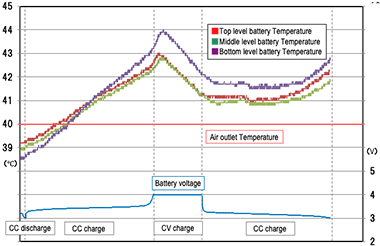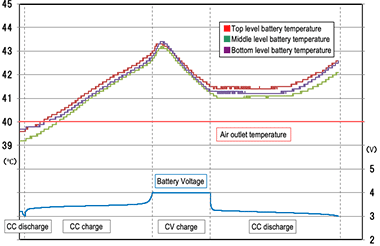Advanced Battery Chamber Next
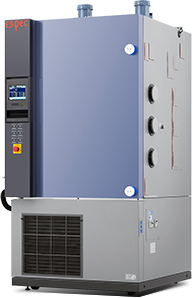
Overview of Equipment
Charge-discharge tests of automotive secondary batteries have problems of being unable to perform accurate evaluation and having differences in environment temperature due to high heating of the battery during high input-output characteristic measurement and increased heat generation caused by battery degradation during long cycle and life testing.
In addition, when charge-discharge testing several batteries installed in the test area at the same time, deviations in temperature uniformity and heat generation of a battery to be cause of changes in the heat history of the batteries, thereby hindering correct evaluation.
In an effort to solve these problems, ESPEC applied its long-cultivated environment control technology to develop the Advanced Battery Chamber Next (precision temperature control chamber) with multi-area temperature control.
Main specifications (example)
Please scroll horizontally to look at table below.
| Category | Item | Specifications and features |
|---|---|---|
| Performance | Temperature range | -40°C to +100°C |
| Temperature uniformity | ±0.5°C (deviation from temperature setting for central air temperature (total 6 points) for each battery installation area) | |
| Allowable heat load | 500 W (at -20°C with air temperature control) | |
| Dimensions | Inside dimensions (W × H × D mm) |
800 × 790 × 525 (excluding protrusions) |
| Outside dimensions (W × H × D mm) |
1000 × 2196 × 1255 (including protrusions) | |
| Safety Devices | Pressure release vent | φ100mm |
| Options | Specimen temperature control | Applicable temperature range: -20°C to +60°C Allowable heat load: Supports number of specimens and usage temperature range |
| Relay module | Supports no-wiring inside of test area with test chamber rear pass-through method (Standard: φ 100 cable port × 3) | |
| CO2 fire extinguisher | Automatically extinguishes fire after detecting heat or smoke at thermal runaway and stops operation, linkable to intake/exhaust damper | |
| Smoke detector | Uses optical spot detector for efficient detection of smoke during thermal runaway | |
| CO/H2 gas detector | Pump suction type that collects gas generated from battery, 2-stage alert, linkable to intake/exhaust damper | |
| Intake/exhaust damper | Supports forced ventilation of gas inside of the chamber after CO2 fire extinguisher spray, interlock to gas detector |
Other test chamber models for charge-discharge testing
Advanced Battery Chamber (ADBC) series
- Features a special design for charge-discharge testing and horizontal laminar flow for high temperature uniformity performance.
- Uses a charge-discharge power supply from another manufacturer and has an integrated design to enable space savings.
Please scroll horizontally to look at table below.
| Item | ADBC-S (1-chamber type) |
ADBC-T (3-chamber type) |
|---|---|---|
| Temperature range | -40°C to +100°C | |
| Temperature uniformity | ±1.5°C | |
| Inside dimensions (W × H × Dmm) |
640 × 850 × 544 | 510 × 400 × 400 × 3 chambers |
| Outside dimensions (W × H × Dmm) |
1250 × 1875 × 1560 | 1200 × 2022 × 1300 |
| Weight (kg) | 540 | 800 |
Features
- Strong support of enhanced reproducibility and accuracy for cycle characteristics and life evaluation testing
-
- Comes with multi-area temperature control (patent pending) that enables separate temperature control in multiple areas of the test area.
Reduces temperature deviations caused by battery heat generation during charge-discharge testing, and contributes to enhanced reproducibility and accuracy for cycle characteristics and life evaluation testing.
- Comes with multi-area temperature control (patent pending) that enables separate temperature control in multiple areas of the test area.
- Strong support of enhanced reproducibility and accuracy for temperature characteristics testing and constant current load characteristics testing
-
- Optional specimen temperature control of up to 6 channels for fixed control of battery surface temperature during charge-discharge testing.
This chamber contributes to enhanced reproducibility and accuracy for temperature characteristics testing and constant current load characteristics testing, which require strict control of battery temperature. - Outlet temperature control and specimen temperature control can be switched externally, enabling a repeated test sequence of cycle life characteristics testing and temperature characteristics testing in one test area.
- Optional specimen temperature control of up to 6 channels for fixed control of battery surface temperature during charge-discharge testing.
- Multi-area temperature control
-
- The hybrid air conditioning control system (patent pending) separates the test area into different air conditioning areas and controls the air conditioning in the chamber and the different areas.
- Choose between three or six areas depending on the testing objective.
- Optional specimen temperature control minimizes gaps between the environment temperature and battery surface temperature.
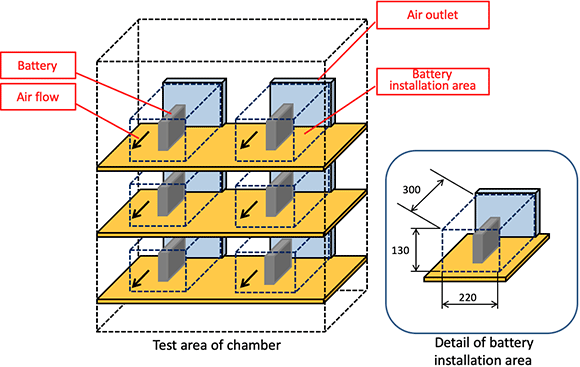 Air conditioning structure of multi-area temperature control
Air conditioning structure of multi-area temperature control
- Change in battery temperature due to charge-discharge and the effects of individual specimen temperature control
-
- One lithium ion battery (40Ah) each is placed on the top, middle, and bottom levels of the test chamber (40°C), and the batteries are charged and discharged at 1C (40A).
- The ADBC-Next performed individual specimen temperature control, and the change in battery temperature was compared to that of the conventional test chamber (conventional test chamber has outlet temperature control).
-
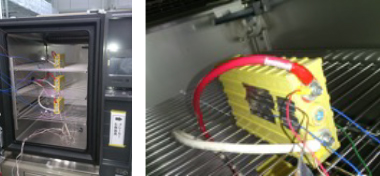 <Conventional test chamber>
<Conventional test chamber>
-
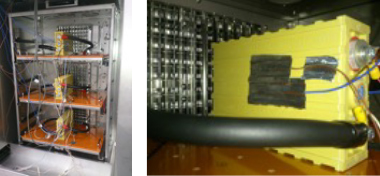 ADBC Next
ADBC Next
- <Conventional test chamber>
-
- Before starting charging, the temperature of the bottom battery is low, and the heat generation caused by charging increases the temperature more than that of the top and middle levels, creating a difference in heat history between batteries.
- Maximum temperature fluctuation is 4°C.
- <Multi-area control (3areas)>
-
- Before starting charging and during charging, the difference in temperature between batteries is nearly constant, therefore the heat history between batteries is nearly the same.
- Maximum temperature fluctuation is 3.4°C
- <Specimen temperature control (3cells)>
-
- There is virtually no deviation to the temperature setting even during charging, and the surface temperature of the batteries remains constant.
- Maximum temperature fluctuation is 0.3°C.




